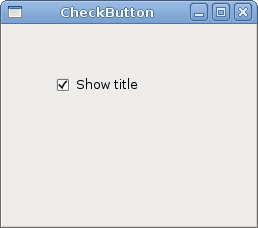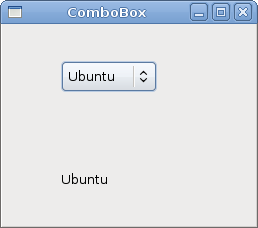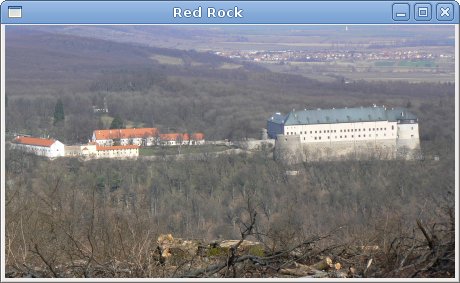Widgets in GTK#
In this part of the GTK# programming tutorial, we will introduce some GTK# widgets.
Widgets are basic building blocks of a GUI application. Over the years, several widgets became a standard in all toolkits on all OS platforms. For example a button, a check box or a scroll bar. The GTK# toolkit's philosophy is to keep the number of widgets at a minimum level. More specialised widgets are created as custom GTK# widgets.
Label
The Label widget shows text.
using Gtk;
class SharpApp : Window {
string text = @"Meet you downstairs in the bar and heard
your rolled up sleeves and your skull t-shirt
You say why did you do it with him today?
and sniff me out like I was Tanqueray
cause you're my fella, my guy
hand me your stella and fly
by the time I'm out the door
you tear men down like Roger Moore
I cheated myself
like I knew I would
I told ya, I was trouble
you know that I'm no good";
public SharpApp() : base("You know I'm No Good")
{
BorderWidth = 8;
SetPosition(WindowPosition.Center);
DeleteEvent += delegate { Application.Quit(); };
Label lyrics = new Label(text);
Add(lyrics);
ShowAll();
}
public static void Main()
{
Application.Init();
new SharpApp();
Application.Run();
}
}
The code example shows some lyrics on the window.
string text = @"Meet you downstairs in the bar and heard your rolled up sleeves and your skull t-shirt ...
In C# programming language, multiline string is preceded with the @ character.
BorderWidth = 8;
The Label is surrounded by some empty space.
Label lyrics = new Label(text); Add(lyrics);
The Label widget is created and added to the window.

CheckButton
CheckButton is a widget that has two states: on and off. The On state is visualised by a check mark. It is used to denote some boolean property.
using Gtk;
using System;
class SharpApp : Window {
public SharpApp() : base("CheckButton")
{
SetDefaultSize(250, 200);
SetPosition(WindowPosition.Center);
DeleteEvent += delegate { Application.Quit(); };
CheckButton cb = new CheckButton("Show title");
cb.Active = true;
cb.Toggled += OnToggle;
Fixed fix = new Fixed();
fix.Put(cb, 50, 50);
Add(fix);
ShowAll();
}
void OnToggle(object sender, EventArgs args)
{
CheckButton cb = (CheckButton) sender;
if (cb.Active) {
Title = "CheckButton";
} else {
Title = " ";
}
}
public static void Main()
{
Application.Init();
new SharpApp();
Application.Run();
}
}
We will display a title in the titlebar of the window, depending on the state of the CheckButton.
CheckButton cb = new CheckButton("Show title");
CheckButton widget is created.
cb.Active = true;
The title is visible by default, so we check the check button by default.
CheckButton cb = (CheckButton) sender;
Here we cast the sender object to CheckButton class.
if (cb.Active) {
Title = "CheckButton";
} else {
Title = " ";
}
Depending on the Active property of the CheckButton, we show or hide the title of the window.

ComboBox
ComboBox is a widget that allows the user to choose from a list of options.
using Gtk;
using System;
class SharpApp : Window {
Label label;
public SharpApp() : base("ComboBox")
{
string[] distros = new string[] {"Ubuntu",
"Mandriva",
"Red Hat",
"Fedora",
"Gentoo" };
SetDefaultSize(250, 200);
SetPosition(WindowPosition.Center);
BorderWidth = 7;
DeleteEvent += delegate { Application.Quit(); };
Fixed fix = new Fixed();
ComboBox cb = new ComboBox(distros);
cb.Changed += OnChanged;
label = new Label("-");
fix.Put(cb, 50, 30);
fix.Put(label, 50, 140);
Add(fix);
ShowAll();
}
void OnChanged(object sender, EventArgs args)
{
ComboBox cb = (ComboBox) sender;
label.Text = cb.ActiveText;
}
public static void Main()
{
Application.Init();
new SharpApp();
Application.Run();
}
}
The example shows a combo box and a label. The combo box has a list of six options. These are the names of Linux distros. The label widget shows the selected option from the combo box.
string[] distros = new string[] {"Ubuntu",
"Mandriva",
"Red Hat",
"Fedora",
"Gentoo" };
This is an array of strings that will be shown in the ComboBox widget.
ComboBox cb = new ComboBox(distros);
The ComboBox widget is created. The constructor takes the array of strings as a parameter.
void OnChanged(object sender, EventArgs args)
{
ComboBox cb = (ComboBox) sender;
label.Text = cb.ActiveText;
}
Inside the OnChanged() method, we get the selected text out of the combo box and set it to the label.

Image
The next example introduces the Image widget. This widget displays pictures.
using Gtk;
using System;
class SharpApp : Window {
Gdk.Pixbuf castle;
public SharpApp() : base("Red Rock")
{
BorderWidth = 1;
SetPosition(WindowPosition.Center);
DeleteEvent += delegate { Application.Quit(); };
try {
castle = new Gdk.Pixbuf("redrock.png");
} catch {
Console.WriteLine("Image not found");
Environment.Exit(1);
}
Image image = new Image(castle);
Add(image);
ShowAll();
}
public static void Main()
{
Application.Init();
new SharpApp();
Application.Run();
}
}
We show the Red Rock castle in the window.
try {
castle = new Gdk.Pixbuf("redrock.png");
} catch {
Console.WriteLine("Image not found");
Environment.Exit(1);
}
We create the Gdk.Pixbuf widget. We put the constructor between the try and catch keywords to handle possible errors.
Image image = new Image(castle); Add(image);
Image widget is created and added to the window.

In this chapter, we showed the first pack of basic widgets of the GTK# programming library
